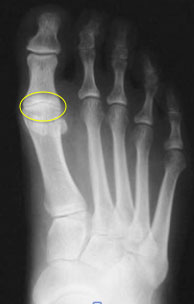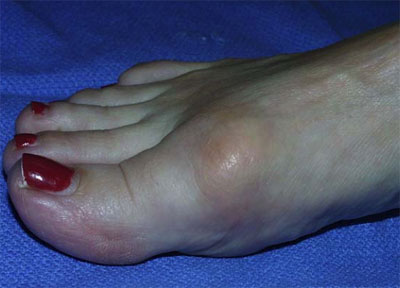Big toe arthritis
Hallux Rigidus

What is a hallux rigidus?
Hallux rigidus is arthritis (wear and tear) of the joint of the big toe. It causes a destruction of the normal working of the big toe joint. The term 'hallux' means the big toe and 'rigidus' means stiffness.
What causes hallux rigidus?
 There has been no definite cause found for hallux rigidus. The big toe takes an enormous amount of pressure during normal gait. Almost twice the amount of body weight passes through the big toe during each step which may cause wear and tear of the joint. People with flat feet may be predisposed to this condition due to the abnormal forces passing through this joint when the arch of the foot collapses.
There has been no definite cause found for hallux rigidus. The big toe takes an enormous amount of pressure during normal gait. Almost twice the amount of body weight passes through the big toe during each step which may cause wear and tear of the joint. People with flat feet may be predisposed to this condition due to the abnormal forces passing through this joint when the arch of the foot collapses.
What are the symptoms caused by hallux rigidus?
In the early stages you may experience
- Pain and stiffness of the big toe
- Swelling and redness around the big toe joint
- Pain or stiffness may worsen in cold or damp weather
- Difficulty with running
As it progress you may develop
- Pain at rest
- A bony bump 'osteophyte' over the top of the big toe which may rub against the shoe
How is this condition diagnosed?
Your consultant will examine your foot clinically and this usually makes the diagnosis clear. Particularly pain on attempts to move the big toe joint with reduced range of movement. X-rays of the foot are also taken to determine how severe the condition is.
Can the condition worsen?
Big toe arthritis may gradually deteriorate over several years. Initially you may experience just stiffness of the big toe but with time pain may also develop particularly on running or walking. As the condition deteriorates one may also get pain at rest.
What treatment options are there?
Options are based on the degree of arthritis in the big toe
Foot wear modification
Pain often occurs when the big toe bends upwards during walking.The thinner the sole of the shoe, and the higher the heel, the worse are going to be the symptoms from this condition. Therefore a shoe with a well supported stiff sole, will help reduce the amount of movement of the big toe during walking and help with your symptoms. A 'rocker-bottom' shoe may also help as it allows the big toe to rock forward rather than bend during gait. A 'large toe box' shoe is preferred to a narrow pointy toe shoe.
Non steroidal anti- inflammatories
A large number of patients will have good control of symptoms with non steroidal anti inflammatory medicines and may not require anything further.
Steroid Injections
These can be given for relief of pain in the short to medium term. These can be offered for an acute flare up of symptoms and help by reducing the inflammation in the joints.
Surgery
Several surgical options are available and your consultant will tailor based on your symptoms and degree of arthritis.
'Cheilectomy' involves removing the bony bump at the top of the big toe which usually causes irritation whilst wearing shoes. The big toe joint may either be fused or replaced. Fusion creates a stiff big toe which will be done with a small plate and screws. This eliminates the pain in the big toe but sacrifices movement. This is ideal for young active patients. A joint replacement on the other hand will help preserve movement but the results of a replacement are not as predictable as a fusion. A fusion remains the gold standard treatment for big toe arthritis.
Is surgery necessary?
The decision to proceed with surgery should be taken after non surgical options described above have been exhausted. The majority of patients will benefit from shoe wear modifications and simple painkillers. If symptoms continue to affect lifestyle and function inspite of this then surgery may be discussed with your consultant.
